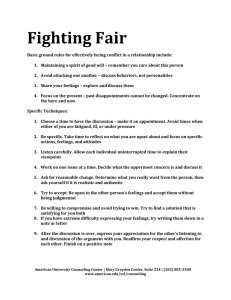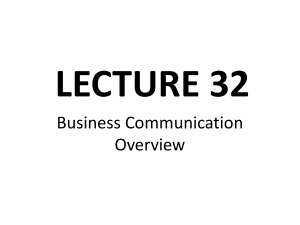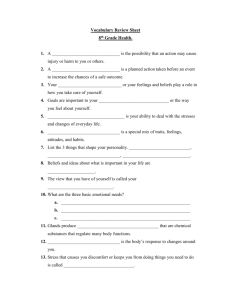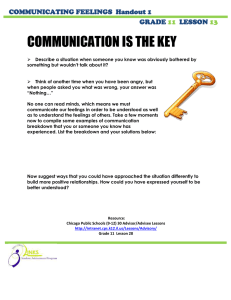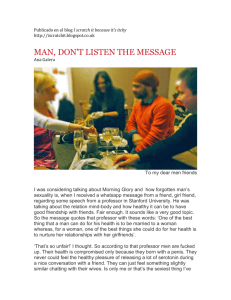Jason A. Scott STS.010: Paper 2 Due: Oct. 21, 2008
advertisement
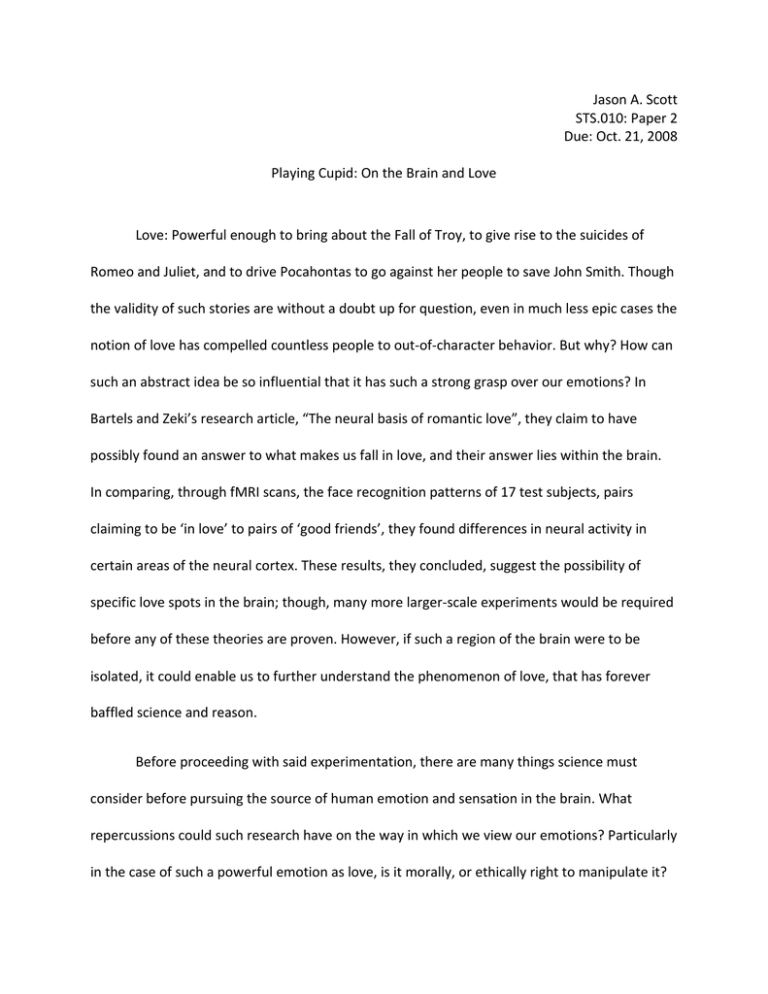
Jason A. Scott STS.010: Paper 2 Due: Oct. 21, 2008 Playing Cupid: On the Brain and Love Love: Powerful enough to bring about the Fall of Troy, to give rise to the suicides of Romeo and Juliet, and to drive Pocahontas to go against her people to save John Smith. Though the validity of such stories are without a doubt up for question, even in much less epic cases the notion of love has compelled countless people to out‐of‐character behavior. But why? How can such an abstract idea be so influential that it has such a strong grasp over our emotions? In Bartels and Zeki’s research article, “The neural basis of romantic love”, they claim to have possibly found an answer to what makes us fall in love, and their answer lies within the brain. In comparing, through fMRI scans, the face recognition patterns of 17 test subjects, pairs claiming to be ‘in love’ to pairs of ‘good friends’, they found differences in neural activity in certain areas of the neural cortex. These results, they concluded, suggest the possibility of specific love spots in the brain; though, many more larger‐scale experiments would be required before any of these theories are proven. However, if such a region of the brain were to be isolated, it could enable us to further understand the phenomenon of love, that has forever baffled science and reason. Before proceeding with said experimentation, there are many things science must consider before pursuing the source of human emotion and sensation in the brain. What repercussions could such research have on the way in which we view our emotions? Particularly in the case of such a powerful emotion as love, is it morally, or ethically right to manipulate it? Who is to make the call on where to draw the line? There are many questions to be considered, most of which revolving around the social implications of neuro‐research. Throughout the history of science, and particularly in the field of human biology, once a discovery is proven legitimate, usually the next step for scientists is figuring out a way to manipulate their findings. If this is to be the case for research in neuroscience, one must wonder the consequences of manipulating the brain and human emotion. Would science find a way to synthesize love? In theory, such a discovery could have plenty of positive implications for our society. Couples experiencing relationship troubles could pay a surgeon to make them fall in love once again. Or better yet, perhaps those experiencing issues with trust and fidelity will simply be able to make a trip to the nearest Walgreens or grocery store to pick up an over‐the‐counter prescription of vasopressin, which according to Professor Larry Young from Emory University may cause fidelity in mammals. Imagine a scenario in which divorce rates are at an all‐time low, and the number of single‐parent homes in America has been cut in half. This, in retrospect, makes research such as Bartels’s, Zeki’s, and Young’s extremely engaging. However, with the positive implications of research must come the negative. Take for instance the case of those forced against their will into arranged marriages. If such a product or procedure to create synthesized feelings of love were to become readily available, the potential pressure that could be felt by these individuals forced into unhappy marriages to pursue such a treatment would be overwhelming, not only from external sources, but from themselves as well. Furthermore, if we are able to synthetically produce feelings of love, and potentially all other feelings such as hate, envy, and passion. Would we then eventually know enough about them to transform these feelings artificially into computer programs? If robots were able to not only appear human from the outside, but also behave as humans, feeling human emotion, what then would set us apart? Would humanity still be considered the most intelligent species? If we found a way to give human emotion to animals, would we still be the most evolved beings on the planet? Then there is still much to consider when discussing the opposite effect. If we are able to create feelings of passion, fidelity, and love, would we also be able to remove such feelings? In the subsequent aisle of the drugstore would we see a love‐removal therapy, a ‘cure for the broken heart’ pill? One would hope that there would be some sort of regulatory process put into place to prevent those with unstable relationships from going back and forth between the love remedy and love antidote, or better yet, from overdosing on either one. However, as happens with other prescription medication, the possibility of the two drugs being distributed illegally is highly likely. Teenagers in particular, encountering their first experiences of love, relationships, and break‐ups, would likely go to great lengths to get their hands on a cure for heartache. Could the heartache pill be as popular amongst high school and college students a generation or two down the road, as Adderall and Ritalin are today? What greater effects could this have on society itself? There are countless questions of cause‐and‐effect relationships to be considered, yet their answers are difficult to hypothesize. However, precaution must be taken in conducting research on something so critical to humanity as the brain and emotion. This argument is strengthened further upon looking at the additional significance of isolating the love center of the brain. If doctors are able to find ways to manipulate feelings of love and affection between to individuals, what is to stop them from stopping such research with simply male and female relationships? If it is possible to remove whatever it is that makes a man and woman fall in love with one another, is it too possible to remove the same from two males or two females that also feel these feelings of love and affection between one another. Would this new research then be deemed the cure for homosexuality? Or could this research be used to help conservatives and ‘homophobes’ prove that homosexuals do not actually feel the same natural feelings of love as heterosexuals, thus deeming their feelings illegitimate? It seems as though if differences are found in the way in which homosexual brains respond to love‐related stimuli when compared to heterosexuals, that both sides could make two completely opposite arguments: Conservative viewpoints would claim that this proves that homosexuality is unnatural. Whereas liberal views could easily counter‐argue that differences are intuitive because homosexuals are obviously stimulated differently than heterosexuals. On the other hand, if homosexuals do present the same neural response, the arguments could be made from both sides as well: Liberals now could argue that homosexuality is a product of nature, while conservatives could now claim that homosexual feelings might be legitimate but they are simply a byproduct of the choice to be attracted to members of the same sex. However, these are just a few of the many possible arguments that could be made; Most of which depend on how deep one’s presuppositions have been engraved into their opinions on the matter. Paul Wolpe discusses the propaganda of such research on love and sexuality in his paper, “Ethics and social policy in research on the neuroscience of human sexuality.” Immediately in his paper he points out that, “scientific inquiry into sexuality is among the most ethically charged of all behavioral research” (Wolpe, p. 1). He goes on to point out that the scientific research of a given time period is reflective of the social issues of that given period. This is very much true with studies of the origins of love, and homosexuality. Currently, our society as a whole is extremely divided between issues of love and sexuality. So much so that it has influenced the way in which we approach scientific studies of love in the brain. Everyone has their own agenda, whether it is to prove the legitimacy of homosexuals in love, to discredit homosexuality as unnatural, or to develop a cure for one of humanities most significant ‘flaws’. However, if it were not for these personal agendas, what would come of science, and neurological research in particular. What motivations would scientists have for figuring out why we feel so strongly for our husbands, wives, boyfriends, and girlfriends? Would we even care to know? Is there such a thing as a person who seeks to know the answers to these questions simply for the sole purpose of learning and understanding? It seems as though if such a person does exist, he or she is a rarity among researchers, at least in today’s propaganda driven world. However, this is not to say that having a personal agenda as a scientist should carry a negative connotation. An oncologist with the agenda to find a cure for cancer after losing a close friend or family member to the disease might be personally driven, yet this drive would generally be considered quite noble. The same is said for the geneticist that is researching ways in which to improve crops from harvests in third‐world countries to yield plentiful surpluses to fight poverty and hunger. And more specifically, the same can be said for a good amount of research on affection in the brain, as is pointed out in research done by Larry Young on vasopressin. Young may have discovered the possible link between vasopressin and fidelity in mammals, but he may have inadvertently found an even more promising focal point for his research. After observing the behavioral effects of vasopressin, he believes that his studies and others like his could “open the lid on conditions where our social skills go wrong.” (Kettlewell, p.2) Particularly, he is interested in seeing the possible correlations between vasopressin receptors and patients of autism. In his studies of the social brain, he looks to answer questions of human interaction. “Why do we interact with other people, and what could go wrong in diseases such as autism?” (Kettlewell, p.2) Questions such as these now motivate his research on social interactions in the brain, although it is the fidelity aspect which draws most to reading his article. Could it be that we are more interested in what he has to say about love and our own relationships? Do we empathize more with the topic of fidelity because it is a much more familiar and widespread issue than that of autism? These questions too could be endlessly argued upon. But if questions of love and sexuality are what drive us to finding potential treatments for diseases such as autism, which is more important to focus upon: the means, or the end? BIBLIOGRAPHY Bartels, Andreas and Semir Zeki (27 November 2000). "The neural basis of romantic love" NeuroReport, 11(17), 3829-3824. Kettlewell, Julianna (16 June 2004) "'Fidelity gene' found in voles" BBC News. Wolpe, Paul R. (October 2004). "Ethics and social policy in research on the neuroscience of human sexuality" Nature Neuroscience, 7(10), 1031-1033. MIT OpenCourseWare http://ocw.mit.edu STS.010 Neuroscience and Society Spring 2010 For information about citing these materials or our Terms of Use, visit: http://ocw.mit.edu/terms.


